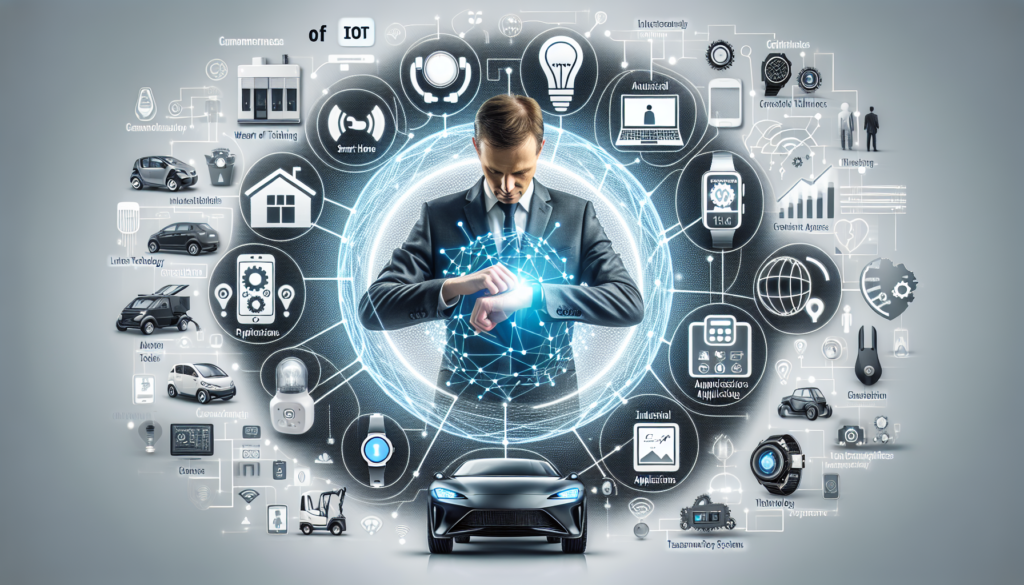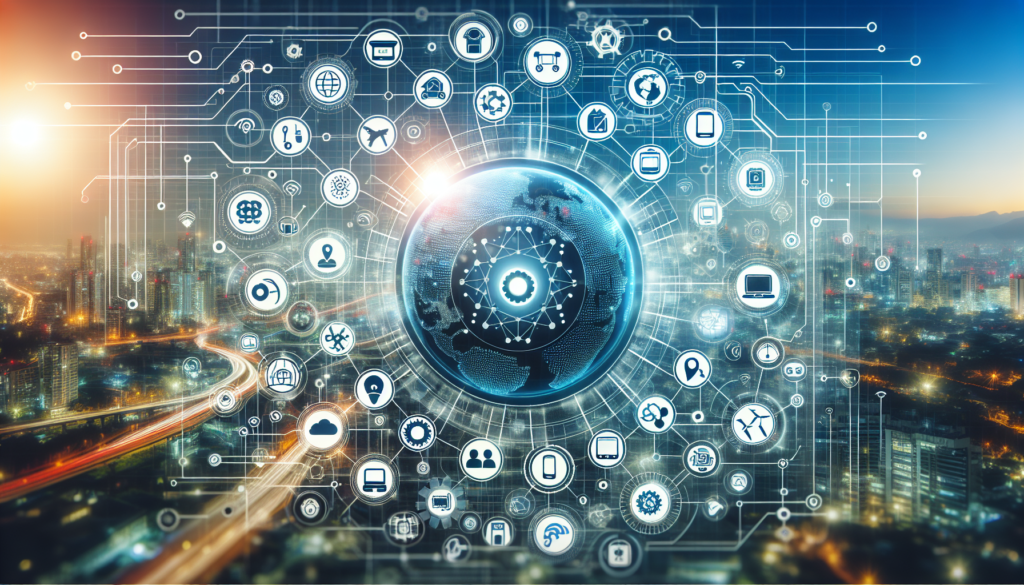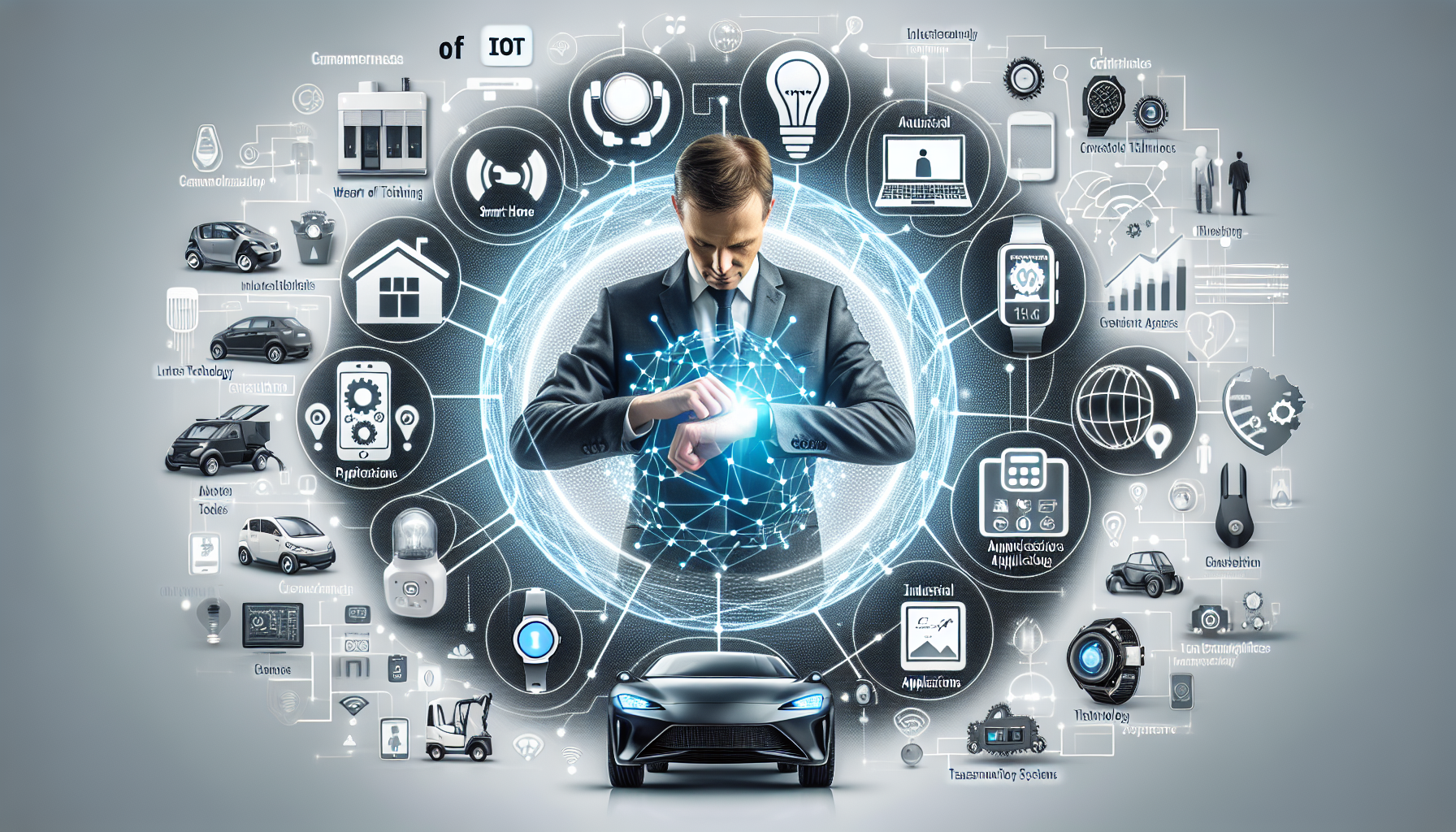In today’s fast-paced world, the concept of the Internet of Things (IoT) has become not only a buzzword but an integral part of our daily lives. The Internet of Things refers to the network of everyday objects connected to the internet, allowing them to send and receive data. From smart thermostats that adjust the temperature based on your preferences to wearable devices that track your health, the IoT has transformed the way we interact with technology. So, what exactly is the Internet of Things today? Let’s explore the fascinating world of IoT and discover how it is shaping our present and future.

Defining the Internet of Things
Understanding the concept
The Internet of Things (IoT) refers to the network of interconnected physical devices, vehicles, appliances, and other objects that are embedded with sensors, electronics, software, and network connectivity, allowing them to collect and exchange data. This concept involves the integration of the physical and digital worlds, creating a seamless and smart network of devices that can interact and communicate with each other.
Integration of physical and digital systems
The integration of physical and digital systems is at the core of the Internet of Things. By connecting everyday objects to the internet, these objects become “smart” and gain the ability to communicate and interact with one another. This integration allows for increased efficiency, automation, and improved decision-making, ultimately transforming the way we live, work, and interact with our surroundings.
Current Applications of IoT
Smart homes and appliances
One of the most common applications of IoT is in the realm of smart homes and appliances. With IoT technology, you can control and monitor various aspects of your home, such as temperature, lighting, security systems, and even appliances, all from the convenience of your smartphone. Smart devices, such as thermostats, cameras, and voice assistants, can communicate with each other to create a seamless and connected living environment.
Connected cars and transportation
IoT has also made its way into the automotive industry, transforming cars into connected vehicles. With features like GPS navigation, real-time traffic updates, and remote access to vehicle controls, IoT allows for a safer and more efficient driving experience. Additionally, connected cars can collect valuable data that can be used for predictive maintenance, improving fuel efficiency, and enhancing overall road safety.
Healthcare and wearables
In the healthcare sector, IoT technology has led to the development of wearable devices that can track and monitor vital signs, physical activity, and sleep patterns. These devices, such as fitness trackers and smartwatches, provide valuable data to both individuals and healthcare professionals, enabling better health management and preventive care. IoT has also contributed to the development of telemedicine, allowing healthcare providers to remotely monitor and assist patients.
Smart cities and infrastructure
IoT has the potential to make cities smarter and more efficient. By integrating various systems and infrastructure, such as transportation, energy, and waste management, cities can optimize resource allocation, reduce energy consumption, and enhance overall sustainability. Smart sensors and networks can collect real-time data, enabling municipalities to make better-informed decisions and improve the quality of life for citizens.
Industrial applications
IoT is revolutionizing industries by improving operational efficiency, reducing costs, and enabling predictive maintenance. In manufacturing, IoT enables machines and equipment to communicate and share data, leading to increased productivity and reduced downtime. Supply chains can be optimized through real-time tracking and monitoring, ensuring timely delivery and minimizing errors. Overall, IoT is transforming industries by enabling automation, data-driven decision-making, and improved performance.
How IoT Works
Sensors and devices
At the heart of IoT are sensors and devices. These small electronic components are embedded in objects and have the ability to collect data from the surrounding environment. Sensors can detect changes in temperature, light, movement, and various other parameters, depending on their purpose. Devices, such as smartphones, wearables, and smart appliances, act as a gateway for data transmission, processing, and communication.
Connectivity options
To enable communication between IoT devices, various connectivity options are used. Wi-Fi, Bluetooth, and cellular networks are common choices for connecting devices within a local area. For devices that need long-range connectivity, technologies like LoRaWAN and Sigfox can be used. In some cases, IoT devices may also utilize satellite networks for connectivity, especially in remote areas or for applications like asset tracking and monitoring.
Data collection and processing
Once the data is collected by the sensors, it is transmitted to a central hub or cloud server for processing. This data can range from environmental conditions to machine performance metrics. In the cloud, data is analyzed, transformed, and stored for further use. Edge computing, where data processing is done locally on the device or at the network’s edge, is also gaining popularity to reduce latency and handle real-time requirements.
Cloud computing and storage
Cloud computing and storage play a crucial role in the functioning of IoT. The massive amount of data generated by IoT devices requires scalable and secure storage infrastructure. Cloud platforms provide the necessary computing power and storage capabilities to process and store this data. Additionally, cloud services enable data analytics, machine learning, and artificial intelligence applications, making sense of the collected data and providing valuable insights.
Challenges and Concerns in IoT
Security and privacy risks
With the increased connectivity and data exchange in IoT, security and privacy risks have become major concerns. IoT devices can be vulnerable to cyberattacks, and a breach in security can lead to unauthorized access to personal information or control over connected devices. To mitigate these risks, robust security measures such as encryption, authentication, and access controls must be implemented to ensure the integrity and confidentiality of data.
Lack of standardization
The lack of standardized protocols and frameworks is another challenge in IoT. With a wide range of devices, sensors, and connectivity options available, interoperability becomes a challenge. Without standardized protocols, integrating devices from different manufacturers and ensuring seamless communication becomes complex. Standardization efforts are underway to establish common frameworks that can enable interoperability and ease the development and deployment of IoT solutions.
Connectivity issues and scalability
IoT relies heavily on connectivity, and network availability and reliability are crucial for seamless communication. However, connectivity issues, such as network congestion or coverage limitations, can hinder the proper functioning of IoT devices. Scalability is another challenge, as the number of connected devices continues to grow exponentially. Ensuring reliable and scalable connectivity infrastructure is essential to support the expanding IoT ecosystem.
Ethical considerations
As IoT becomes more pervasive, ethical considerations come to the forefront. The collection and use of personal data raise concerns about privacy and consent. Additionally, the automation and decision-making capabilities of IoT systems raise ethical questions about accountability and transparency. It is important to address these ethical considerations to ensure that IoT technologies are developed and deployed in a responsible and ethical manner.

Emerging Trends in IoT
Artificial Intelligence and machine learning
Artificial Intelligence (AI) and machine learning are playing a significant role in shaping the future of IoT. By leveraging AI algorithms, IoT systems can make intelligent decisions and predictions based on the collected data. AI-powered analytics can extract valuable insights, detect patterns, and enable proactive responses to real-time events. Machine learning techniques can also improve the efficiency and accuracy of IoT systems by continuously learning from data and adapting to changing conditions.
Edge computing
Edge computing is gaining momentum in the IoT landscape. With edge computing, data processing and analysis are performed locally on the devices or at the network’s edge, rather than relying on centralized cloud servers. This reduces latency, improves real-time responsiveness, and lowers the amount of data that needs to be transmitted to the cloud. Edge computing is particularly beneficial in scenarios where real-time decision-making or low latency is critical, such as autonomous vehicles or industrial automation.
Blockchain technology
Blockchain, the technology behind cryptocurrencies like Bitcoin, is finding applications in IoT as well. Blockchain’s decentralized and tamper-proof nature makes it suitable for secure and transparent data exchange in IoT networks. It can provide immutability, traceability, and trust in transactions, making it ideal for applications such as supply chain management, asset tracking, and data sharing between multiple parties. Blockchain technology has the potential to enhance security, privacy, and data integrity in IoT systems.
5G networks
The deployment of 5G networks is set to revolutionize IoT connectivity. 5G networks offer higher bandwidth, lower latency, and increased device density compared to previous generations of cellular networks. This enables faster and more reliable communication between IoT devices and paves the way for new applications and use cases. With 5G, IoT devices can transfer larger amounts of data, enabling real-time applications, such as remote robotic surgery or augmented reality, and supporting the massive scale of connected devices in the future.
IoT in Everyday Life
Smart home automation
One of the most visible applications of IoT in everyday life is smart home automation. Imagine being able to control your lights, thermostat, and security system from your smartphone or using voice commands. IoT technology allows for seamless integration of various devices and appliances in your home, enabling enhanced comfort, convenience, and energy efficiency. Smart speakers, such as Amazon Echo or Google Home, act as a central hub, connecting and controlling all the smart devices in your home.
Wearable devices and health tracking
Wearable devices and health tracking have become increasingly popular, thanks to IoT. Fitness trackers, smartwatches, and even smart clothing can monitor your physical activity, heart rate, sleep patterns, and other vital signs. This data can be synced to your smartphone or cloud platform, allowing you to track your health goals, gain insights into your well-being, and even share the information with healthcare providers. IoT-enabled wearables have the potential to revolutionize personal health management and preventive care.
Connected cars and autonomous vehicles
The automotive industry has witnessed significant advancements with IoT technology. Connected cars can now provide real-time navigation, remote vehicle controls, and proactive maintenance alerts. IoT connectivity also enables vehicle-to-vehicle communication, enhancing road safety and enabling features like collision avoidance systems. Autonomous vehicles, which rely heavily on IoT, are poised to revolutionize transportation by reducing accidents, congestion, and environmental impact, while providing a more efficient and convenient mode of travel.
The Future of IoT
Expanding connectivity and device adoption
The future of IoT is characterized by ever-expanding connectivity and device adoption. As technology evolves, more objects and devices will become connected, and the number of sensors and IoT devices will continue to grow exponentially. This expansion of the IoT ecosystem will drive innovation, create new business opportunities, and transform various industries and sectors.
IoT in enterprises and industries
Enterprises and industries are increasingly recognizing the potential of IoT to drive operational efficiency, improve productivity, and enable new business models. IoT solutions are being utilized in areas such as asset tracking, supply chain management, predictive maintenance, and energy management. As organizations harness the power of IoT, they will gain valuable insights, optimize processes, and unlock new revenue streams.
Increased integration and interoperability
To address the challenges of interoperability and integration, there will be a greater emphasis on standardization and collaboration. Efforts are underway to establish common frameworks, protocols, and interoperability guidelines, enabling seamless communication and interaction between different IoT devices and systems. This increased integration and interoperability will drive innovation, foster collaboration, and unlock the full potential of IoT across various domains.
IoT and Data Analytics
Data-driven decision making
The abundance of data generated by IoT devices presents a great opportunity for data-driven decision making. Through advanced analytics, organizations can derive valuable insights from IoT data, enabling them to make informed decisions and optimize operations. Real-time data analytics can identify patterns, trends, and anomalies, providing actionable insights that can drive efficiency, productivity, and innovation.
Predictive maintenance
One of the key advantages of IoT is its ability to enable predictive maintenance. By continuously monitoring and analyzing sensor data from machines and equipment, organizations can predict maintenance needs, identify potential failures, and schedule maintenance activities proactively. This predictive approach helps reduce downtime, improve asset performance, and minimize costs associated with unplanned maintenance. Predictive maintenance is particularly valuable in industries such as manufacturing, energy, and transportation.
Improving efficiency and productivity
IoT has the potential to greatly improve efficiency and productivity across various sectors. By automating processes, optimizing workflows, and enabling real-time monitoring, organizations can streamline operations, reduce waste, and improve resource allocation. IoT data analytics can provide insights into inefficiencies and bottlenecks, enabling organizations to optimize their operations and achieve higher productivity levels.
The Impact of IoT on Society
Improved quality of life
IoT has the potential to greatly improve the quality of life for individuals and communities. Through smart homes, connected healthcare devices, and wearable technology, IoT can enhance comfort, convenience, and well-being. Smart cities equipped with IoT infrastructure can optimize resource usage, reduce pollution, and improve the overall livability of urban areas. The seamless integration of IoT in our daily lives can result in a more connected and efficient society.
Enhanced healthcare systems
IoT is revolutionizing healthcare by enabling remote patient monitoring, telemedicine, and personalized care. Connected healthcare devices can continuously monitor patients’ vital signs, allowing healthcare providers to remotely track their condition and intervene when necessary. This remote monitoring and telemedicine approach improve access to healthcare, especially in rural or underserved areas. IoT-enabled healthcare systems have the potential to reduce healthcare costs, improve patient outcomes, and enhance overall healthcare delivery.
Smart and sustainable cities
IoT plays a pivotal role in building smart and sustainable cities. By integrating various systems and infrastructure, cities can optimize energy usage, reduce waste, and enhance transportation networks. IoT-enabled sensors can monitor air quality, detect noise levels, and manage traffic flow, contributing to a healthier and more livable urban environment. Smart city initiatives powered by IoT hold the promise of sustainable urban development, improved resource management, and enhanced quality of life for residents.
Conclusion
The Internet of Things is a transformative technology that is revolutionizing the way we interact with our environment and the objects around us. With its integration of physical and digital systems, IoT is enabling efficient automation, data-driven decision making, and improved quality of life. From smart homes to connected cars, healthcare to industrial applications, IoT has a wide range of practical applications. As emerging trends such as AI, edge computing, blockchain, and 5G continue to shape the IoT landscape, the future holds even greater possibilities. The continued growth and innovation in IoT will pave the way for a more connected and intelligent world.
